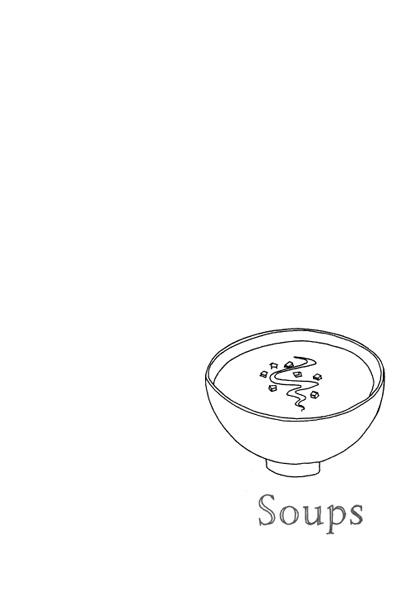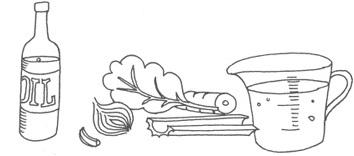The Thrifty Cookbook: 476 Ways to Eat Well With Leftovers (20 page)
Read The Thrifty Cookbook: 476 Ways to Eat Well With Leftovers Online
Authors: Kate Colquhoun
Tags: #General, #Cooking

BOOK: The Thrifty Cookbook: 476 Ways to Eat Well With Leftovers
2.68Mb size Format: txt, pdf, ePub
If you are making a soup or dip and simply don’t have any bread to serve with it, pittas will give the impression that you are a bit of a baking genius hiding your light under a bushel. Thrifty cooking is not necessarily about impressing, but what the hell…
Bear in mind that – with all that rising – pittas do take a bit of time to prepare. As with Emergency Bread, you can flavour them to your taste by adding a spoonful or two of your favourite flavouring, such as herbs or olives, to the dough.
Makes 8-10
370g plain flour
1 heaped teaspoon easy-blend yeast
2 teaspoons sea salt
50ml olive oil
200ml warm water
Sift the flour into a warm bowl and stir in the yeast and salt. Add the oil and about two-thirds of the water and mix well, then gradually add enough of the remaining water to make a claggy dough. Turn out on to a lightly floured surface and knead for 3 minutes or so, until the dough begins to feel soft and elastic. Cover and leave for 15 minutes, then knead again for 3 minutes. Transfer to a clean oiled bowl, cover with cling film and leave in a warm (but not hot) place to rise for an hour.
Knock back the dough by quickly punching out the air on a floured surface for a minute or so, then return it to the bowl, cover with cling film and leave to rise for a further hour or so, until doubled in size.
Divide the dough into 8-10 pieces and roll each into a ball. Cover with a damp tea towel and leave for half an hour – they will continue to rise.
Preheat the oven to 240°C/Gas Mark 9. Roll out each ball into a rough circle about 5mm thick. Place on non-stick baking trays and bake for around 4-5 minutes. The breads will puff up and begin to colour just lightly. Once they are ready, remove the pittas from the oven and leave to cool under a cloth or they will harden and crack.
There really is no point in buying croûtons when they cost practically nothing and take only a minute or two to make. Use up the stale ends of brown or white bread.
Cut the bread into 1cm dice (remove the crusts first, if you like). Heat some olive oil in a frying pan over a medium heat and when it is shimmering, toss in the bread, coating it with a little of the oil. Stirring occasionally, let the bread crisp and turn just golden on both sides. Remove from the pan and drain on kitchen paper. Add to soups or salads.
Flavoured croûtons
You could flavour your croûtons by adding a little chopped garlic, herbs or chilli to the oil and letting it cook for barely a minute (being careful that it doesn’t burn) before removing with a slotted spoon. Then use this flavoured oil for frying the bread.
Buttery croûtons
Use butter instead of oil. Heat it until it is foaming but be careful that it does not burn – butter turns brown and bitter if overheated.

Soups are just about the simplest things to make, because they cook themselves while you get on with something else. They are the most natural way of using up leftovers or languishing vegetables – with, perhaps, a few extras from the store cupboard. They come in every colour and texture too, from an almost transparent broth to the deepest, chunkiest meal-in-a-bowl.
Soups almost always start with a chopped onion, a crushed clove of garlic and a little chopped carrot and/or celery, which are softened in oil before you add the main ingredient plus some stock or water. Once you’ve got the basic method taped, whatever you make will be limited only by the ingredients available and your own particular taste.
Home-made stock (see
pages 27
-
30
) really comes into its own now, especially if what you feel like eating is a simple, clear broth with just the addition of a handful of fresh herbs, a few shreds of leftover meat or fish or a couple of meatballs. In this case, follow the instructions for clarifying stock on
page 29
. Of course, you can use stock powder or cubes instead – just make them fairly dilute, and go easy when adding extra salt. Or, just use water – the flavour from the onion, carrot and celery with perhaps a bay leaf is often all you really need.
Texture is a matter of personal preference. If chunky soups are your thing, chop all the ingredients to your ideal size. For smooth soups, simply let the cooked soup cool and then blitz it. To serve, reheat the soup in a clean pan, but don’t let it boil. If it looks too thick, thin it down with a little water or stock, or swirl in some cream or crème fraîche just before serving. But, if thickness is what you are after, add a diced potato or some starchy canned beans to the soup as it’s cooking.
Soups taste even better the next day, though they often thicken up in the fridge and may need to be thinned with some stock, water or cream. And they freeze brilliantly, though be cautious with soups containing rice or pasta – the carbohydrate will just turn to mush. Remember that liquids expand when frozen, so don’t overfill your bowl, bottle or bag.
Often at the very end of the culinary food chain, soups are also a fantastic way of using up leftover-leftovers. For example, if you make the Tomato, Chorizo and Chickpea Stew on
page 74
and don’t quite finish it, you’ll find that overnight the flavours sink into each other and deepen. With a ladleful of stock or water, this will make an excellent soup – blitzed or chunky, as you like. Try doing this with almost any bake or stew.
Finally, most soups crave a partner: grated hard cheese, a spoonful of cream or plain yogurt, soft cheese such as goat’s cheese, or a drizzling of good olive oil. No soup is at its best without warm crusty bread, plain toast or small cubes of bread gently fried to make croûtons (see
page 52
). Frozen breadcrumbs (see
page 49
), nuts or seeds can also be lightly toasted in a frying pan (keep them moving with a spoon in either case to prevent them burning) for scattering over the top.
It is worth bearing in mind two things when making soups: firstly, that you need to use a large pan: if you want a smooth soup, this will mean that you have room to blitz it all with a hand-held blender without it erupting like Vesuvius. Secondly, it stands to reason that if you use a pressure cooker your cooking time will be reduced, which is helpful for large amounts. (Follow the instructions that come with the cooker.)
The multiple variations on this soup will take you right through the year, from autumn celeriac to summer beans and beetroot. Handy, then, not just for leftovers but for veggie-plot gluts or when fresh food is at its seasonal best and cheapest. Always make sure that the vegetables are cooked until they are completely tender or, when you blend the soup, you will have some pretty inedible lumps.
Other books
King’s Million-Dollar Secret by Maureen Child
Still Life With Woodpecker by Robbins, Tom
Doing the Devil's Work by Bill Loehfelm
Road to Redemption by Natalie Ann
The Collection by Fredric Brown
The Correspondence Artist by Barbara Browning
Dark to Mortal Eyes by Eric Wilson
Dark Mate (MATE series) by Kristen, Natalie
Anna by Norman Collins



